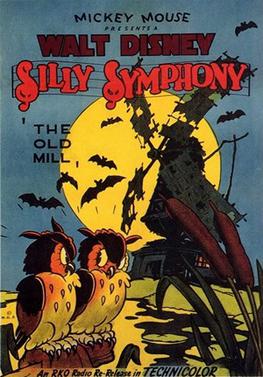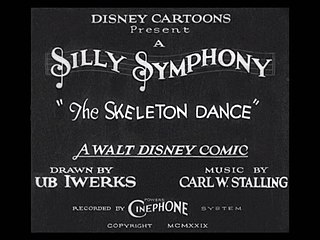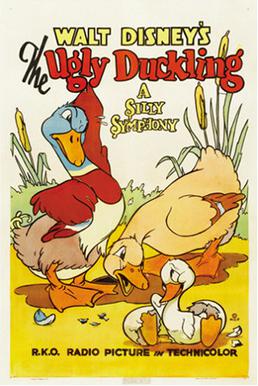Related Research Articles
Silly Symphony is an American animated series of 75 musical short films produced by Walt Disney Productions from 1929 to 1939. As the series name implies, the Silly Symphonies were originally intended as whimsical accompaniments to pieces of music. As such, the films usually did not feature continuing characters, unlike the Mickey Mouse shorts produced by Disney at the same time. The series is notable for its innovation with Technicolor and the multiplane motion picture camera, as well as its introduction of the character Donald Duck making his first appearance in the Silly Symphony cartoon The Wise Little Hen in 1934. Seven shorts won the Academy Award for Best Animated Short Film.

Orphan's Benefit is an American animated short film produced by Walt Disney Productions in black-and-white. It was first released in 1934 and was later remade in Technicolor in 1941 under the corrected title Orphans' Benefit. The cartoon features Mickey Mouse and his friends putting on a vaudeville-style benefit show for a group of unruly orphans. It contains a number of firsts for Disney, including the first time in which Mickey Mouse and Donald Duck appear together, and was the 68th Mickey Mouse short film to be released, and the sixth of that year. It was also the cartoon which had the first story to be written that featured Donald Duck, though it was the second Donald Duck short to be produced and released, after The Wise Little Hen.
Burton F. Gillett was a director of animated films. He is noted for his Silly Symphonies work for Disney, particularly the 1932 short film Flowers and Trees and the 1933 short film Three Little Pigs, both of which were awarded the Academy Award for Best Animated Short Film and both of which were selected for inclusion in the National Film Registry.
ComiColor Cartoons are a series of twenty-five animated short subjects produced by Ub Iwerks from 1933 to 1936. The series was the last produced by Iwerks Studio; after losing distributor Metro-Goldwyn-Mayer in 1934, the Iwerks studio's senior company Celebrity Pictures had to distribute the films itself. The series was shot exclusively in Cinecolor.

The Old Mill is a Silly Symphonies cartoon produced by Walt Disney Productions, directed by Wilfred Jackson, scored by Leigh Harline, and released theatrically to theatres by RKO Radio Pictures on November 5, 1937. The film depicts the natural community of animals populating an old abandoned windmill in the country, and how they deal with a severe summer thunderstorm that nearly destroys their habitat. It incorporates the song "One Day When We Were Young" from Johann Strauss II's operetta The Gypsy Baron.

The Skeleton Dance is a 1929 Silly Symphony animated short subject produced and directed by Walt Disney and animated by Ub Iwerks. In the film, four human skeletons dance and make music around a spooky graveyard—a modern film example of medieval European "danse macabre" imagery. It is the first entry in the Silly Symphony series. In 1993, to coincide with the opening of Mickey's Toontown in Disneyland, a shortened cover of the cartoon's music was arranged to be featured in the land's background ambiance. The short's copyright was renewed in 1957, and as a published work from 1929 it will enter the US public domain on January 1, 2025.
Owen Earl Duvall was an American artist and animator best known for his work on Disney comic strips in the early 1930s and for a handful of animated short films he directed at Warner Bros. Cartoons.
The first wave of Walt Disney Treasures was released on December 4, 2001. It includes four different DVD sets.

The Ugly Duckling is an animated short film by Walt Disney, based on the 1843 fairy tale "The Ugly Duckling" by Hans Christian Andersen. The film was directed by Jack Cutting and Clyde Geronimi, and released in theaters on April 7, 1939. Music was composed by Albert Hay Malotte, who was uncredited for the film. The animated short was first distributed by RKO Radio Pictures, and was shown with Love Affair.

Mother Goose Goes Hollywood is a 1938 animated short film produced by Walt Disney Productions and distributed by RKO Radio Pictures. The short was released on December 23, 1938. The film parodies several Mother Goose nursery rhymes using caricatures of popular Hollywood film stars of the 1930s. The film was directed by Wilfred Jackson and was the third-to-last Silly Symphony produced.

Old King Cole is a Disney cartoon in the Silly Symphonies series, based on several nursery rhymes and fairy tales, including Old King Cole. It was directed by David Hand and released on July 29, 1933.
The Grasshopper and the Ants is a 1934 American animated short film produced by Walt Disney Productions and released by United Artists. Part of the Silly Symphonies series, the film is an adaptation of The Ant and the Grasshopper, one of Aesop's Fables. It was directed by Wilfred Jackson and stars Pinto Colvig as the voice of the grasshopper Hop.

Three Blind Mouseketeers is a Silly Symphonies cartoon based on the nursery rhyme Three Blind Mice and the 1844 novel The Three Musketeers by Alexandre Dumas. Directed by Dave Hand and Jack Cutting, it stars Billy Bletcher.
The Flying Mouse is a Silly Symphonies cartoon produced by Walt Disney, directed by David Hand, and released to theatres by United Artists on July 14, 1934. The use of color here was rather innovative as it is set during the course of a single day.

The Robber Kitten is a 1935 Walt Disney Silly Symphonies cartoon, directed by David Hand.
The Truth About Mother Goose is an animated film released on August 28, 1957, by Walt Disney Productions. The short was directed by Wolfgang Reitherman in his directorial debut, and Bill Justice, and written by Bill Peet.
Springtime is a Silly Symphonies animated Disney short film. It was released in 1929. It was the third Silly Symphonies film to be produced, just five days before the 1929 Stock Market Crash. The short's copyright was renewed in 1957, so it will enter the US public domain on January 1, 2025.
The China Plate is a 1931 Silly Symphonies animated film.
The Busy Beavers is a 1931 Silly Symphonies animated film, directed by Burt Gillett.
Monkey Melodies is a Silly Symphonies animated Disney short film. It was released in 1930 as the 13th film in the Silly Symphony Series.
References
- 1 2 3 4 Merritt, Russell; Kaufman, J. B. (2016). Walt Disney's Silly Symphonies: A Companion to the Classic Cartoon Series (2nd ed.). Glendale, CA: Disney Editions. pp. 88–89. ISBN 978-1-4847-5132-9.
- ↑ "Shorts". Motion Picture Herald : 44. May 9, 1931. Retrieved February 23, 2020.
- ↑ "Sound Shorts". The Film Daily : 11. September 13, 1931. Retrieved February 23, 2020.
- ↑ "Silly Symphonies: The Historic Musical Animated Classics DVD Review". DVD Dizzy. Retrieved February 20, 2021.